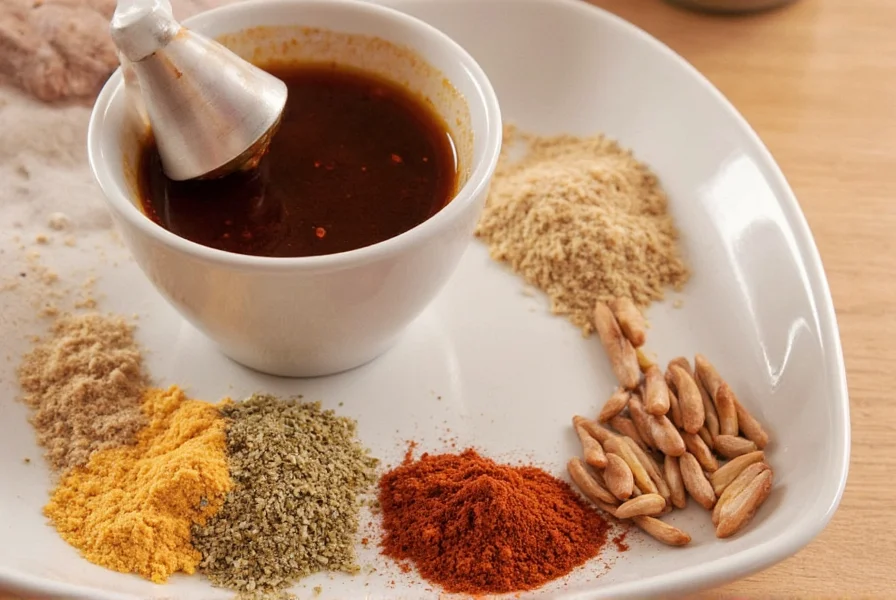Satay Seasoning: A Flavorful Journey Through Global Spice Traditions
Table of Contents
Introduction to Satay Seasoning
Satay seasoning is more than just a mix of spices—it's a gateway to the rich, aromatic world of global cuisine. Originating from Southeast Asia, particularly Indonesia, satay is a beloved dish of grilled meat skewers served with a savory or sweet peanut sauce. But the real magic lies in the seasoning that transforms ordinary meat into an unforgettable feast.
Whether you're a seasoned chef or a home cook looking to elevate your grilling game, understanding the nuances of satay seasoning can make all the difference. It’s a blend of warm, earthy, and sometimes fiery flavors that reflect the cultural roots of the dish. In this article, we’ll dive deep into the history, variations, and practical tips for using satay seasoning, along with a detailed buying guide to help you find the perfect one for your kitchen.

Global Spice Traditions and Satay Seasoning
Satay seasoning isn’t just a regional secret—it’s a reflection of global spice traditions. The ingredients used in satay seasoning often mirror the spice trade routes that connected Asia, the Middle East, and Europe for centuries. Turmeric, coriander, cumin, and lemongrass are common in many cultures, each adding its own unique flavor profile.
For example:
- Indonesian Satay: Uses turmeric, coriander, garlic, and shallots for a deep, golden flavor.
- Malaysian Satay: Often includes lemongrass and ginger for a fresh, zesty twist.
- Thai Satay: May incorporate chili powder or kaffir lime for a spicier, more aromatic experience.
This diversity shows how satay seasoning has evolved over time, adapting to local tastes while still keeping its core identity. It’s a prime example of how spices transcend borders and bring people together through food.

| Country | Key Ingredients | Flavor Profile |
|---|---|---|
| Indonesia | Turmeric, Coriander, Garlic, Shallots | Earthy, Rich, Slightly Sweet |
| Malaysia | Lemongrass, Ginger, Cumin | Fresh, Zesty, Warm |
| Thailand | Chili Powder, Kaffir Lime, Cilantro | Spicy, Citrusy, Herbal |
Practical Tips for Using Satay Seasoning
Whether you’re marinating chicken, beef, or even tofu, satay seasoning is incredibly versatile. Here are some practical tips to get the most out of your seasoning:
- Marinate Overnight: For maximum flavor, let your meat soak in the seasoning for at least 4–6 hours before grilling.
- Adjust Heat Levels: If you prefer a milder version, reduce the amount of chili or omit it altogether.
- Use as a Rub: Apply the seasoning directly to the meat before cooking for a flavorful crust.
- Make Your Own Blend: Experiment with different combinations of spices to match your taste preferences.
- Pair with Peanut Sauce: The seasoning enhances the richness of peanut sauce, creating a balanced and satisfying bite.
One of the best things about satay seasoning is that it’s not limited to meat. Vegetarians and vegans can use it to season grilled vegetables, tofu, or even mushrooms for a delicious plant-based alternative. Just remember to adjust the recipe if you’re making a vegan version—some traditional recipes include coconut milk or other dairy products.
Buying Guide for the Best Satay Seasoning
If you're not making your own satay seasoning, choosing the right store-bought blend can be a game-changer. Here are some key factors to consider when selecting the perfect satay seasoning for your needs:
1. Ingredients and Quality
Look for a seasoning that contains natural, high-quality ingredients like ground turmeric, coriander, cumin, garlic, and lemongrass. Avoid blends with excessive preservatives or artificial additives. Some premium brands may also include organic or non-GMO certifications.
2. Flavor Profile
Depending on your taste, you might prefer a more earthy, spicy, or aromatic blend. Try to find a seasoning that aligns with your preferred level of heat and depth of flavor. Some blends come with a hint of sweetness, which can complement the nuttiness of peanut sauce.
3. Use Cases
Consider how you plan to use the seasoning. If you're grilling meat regularly, a more robust and long-lasting blend may be ideal. For occasional use, a lighter, more delicate option could work better.
4. Target Audience
Some brands cater specifically to home cooks, while others are designed for professional chefs or those who enjoy experimenting with global flavors. Choose a product that matches your skill level and culinary goals.
5. Suitable Occasions
Satay seasoning is great for casual family dinners, backyard barbecues, or even festive celebrations. Look for a product that’s versatile enough to fit various occasions without sacrificing quality.
A few top-rated options include:
- Golden Spices Satay Mix: Known for its rich, earthy flavor and minimal additives. Perfect for grilling chicken or lamb.
- Island Flavors Premium Satay Seasoning: Offers a balance of spice and aroma, ideal for both meat and vegetarian dishes.
- Jungle Blend Satay Seasoning: Features a bold, smoky profile with hints of chili and lemongrass, great for adventurous palates.
Each of these products is suitable for different cooking styles and preferences, so choose one that fits your needs and taste.
Conclusion
Satay seasoning is more than just a condiment—it’s a symbol of cultural exchange, culinary tradition, and the joy of flavor. Whether you’re grilling up a storm in your backyard or exploring new global recipes, this seasoning adds a touch of authenticity and depth to every dish.
By understanding its origins, experimenting with different variations, and choosing the right blend for your kitchen, you can unlock the full potential of satay seasoning. So grab a bottle, fire up the grill, and let your taste buds take a trip around the world.

Remember, the best part of cooking with satay seasoning is the fun of trying new combinations and sharing meals with friends and family. As the saying goes, 'A meal shared is a flavor enjoyed.'










 浙公网安备
33010002000092号
浙公网安备
33010002000092号 浙B2-20120091-4
浙B2-20120091-4